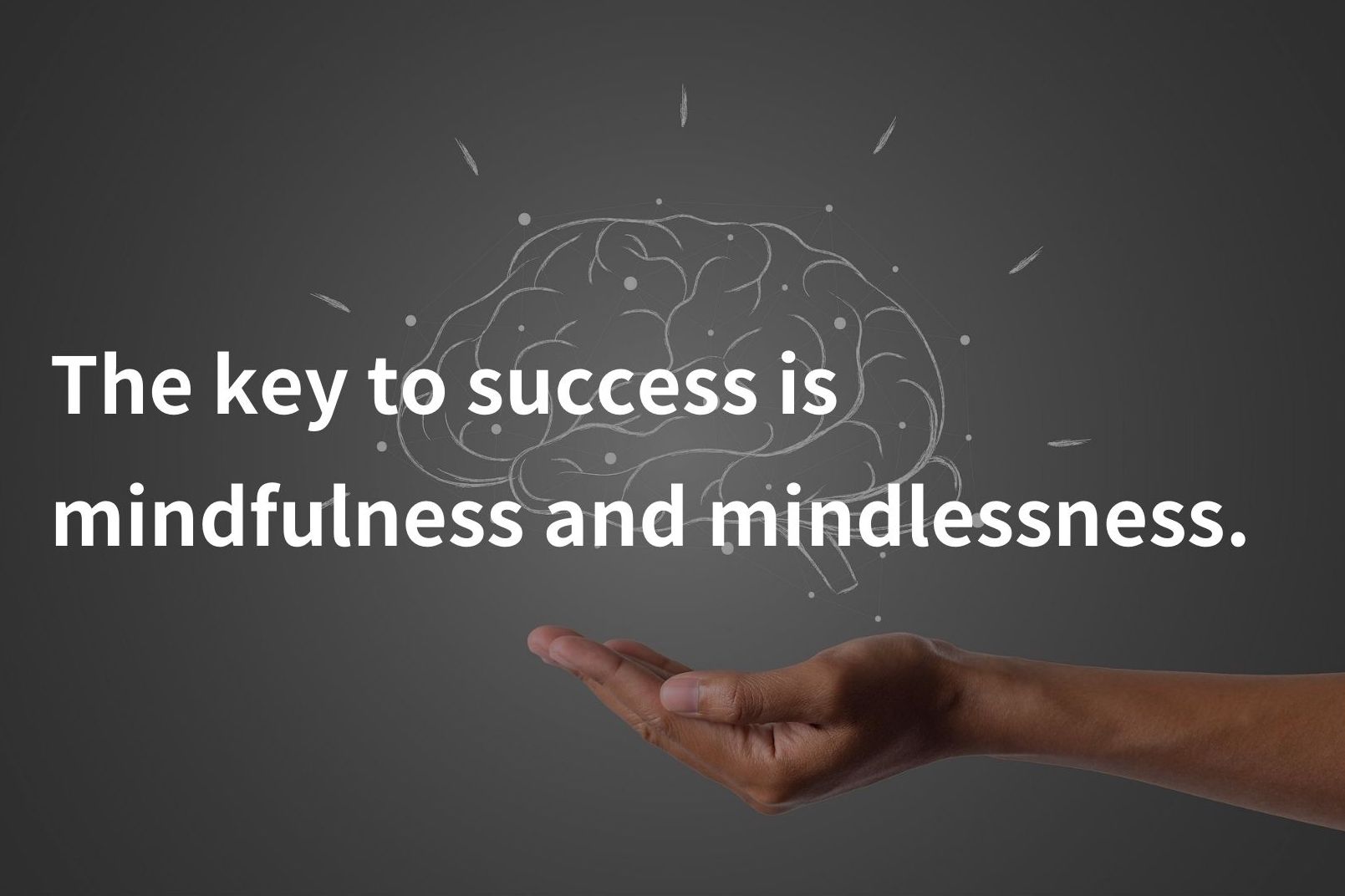
Thank you for reading my blog.
Have you ever wondered something like this?
“What is mindlessness?”
“I’ve heard of mindfulness, but I don’t know mindlessness.”
While the word “mindfulness” has become widely known in the world, the word “mindlessness” has not been heard much yet.
Therefore, in this issue, we would like to share with you that the key to success is the combination of mindfulness and mindlessness.
So let’s get started and find out what mindlessness is and how to use it differently from mindfulness.
Mindfulness is still amazing
Many of you have probably heard the term mindfulness or mindfulness meditation by now.
In a nutshell, mindfulness is conscious awareness.
It is the ability to observe the world you are in as it is.
For example.
- When I see a car, I recognize it as a red car, not a cool one.
- When I fail, instead of thinking that I am a failure, I can think that I am now experiencing disappointment.
Various studies have shown that people who regularly embrace mindfulness are happier, have a greater sense of meaning and purpose in their lives, have higher mental intelligence quotients, are more deeply compassionate toward self, and are better able to cope with chronic stress.
Who wouldn’t think mindfulness is wonderful after hearing the results of this research?
However, mindfulness is not the star of this issue.
Mindlessness is the star of the show.
What exactly is mindlessness and what are its benefits?
The concept of mindlessness
Mindless, simply put, is a state of unfocused as opposed to mindful.
Many people do not have a good impression of the word “unfocused” when it is used to describe an unfocused state.
It seems to be the opposite of mindful, conscious action, strategy, and other manifestations of positive thinking that indicate a person’s superior intelligence, doesn’t it?
But then, why aren’t people designed to be more mindful?
The reason people have evolved to be mindless much of the time is that our ability to process information is extremely limited when we are in a state of conscious thought, that is, constantly aware of what is happening in the present moment.
For example, if you are mindfully walking from your house to the train station, you would have to alternate your feet, measure the distance from the child in front of you, move slightly to the left to avoid bumping into him, and stop where you do not overhang the road because the light is red. This means that you have to be aware of all of these things.
The human brain cannot process such a large amount of complex and moving data at any one moment while being aware of it.
If we try to do so, we will make all kinds of mistakes, such as repeatedly bumping into people in a crowd or hitting another car while driving.
The information processing in your brain is unconsciously processing information at a breakneck pace because otherwise you wouldn’t be able to do it in time.
And in fact, research shows that mindlessness increases productivity and creativity and helps us deal with the messy and unclear issues in our lives.
So let’s check out the next part of this article to see how we can use mindlessness to our advantage.
Three ways to take advantage of mindless
There are three ways to take advantage of mindless conditions.
- Establish a very short deadline if you cannot come to a conclusion after thinking about it for several minutes.
- Place cues or signs that represent your goals in places where you will see them often.
- Have time for idle thoughts.
1. Establish a very short deadline if you cannot come to a conclusion after thinking about it for several minutes.
By limiting the time it takes to reach a conclusion to a short period of time, you are making a mindless decision without denial.
There are often times in our daily lives when we want to do something for no particular reason, but somehow want to do it, or when we are just not in the mood for it.
It is also very common to have a hard time deciding which menu item to choose at a restaurant.
In such cases, instead of taking too much time, let’s follow your first honest feeling.
2. Place cues or signs that represent your goals in places where you will see them often.
Place quotes or pictures that express your goals and motivations on the walls of your room or on your desk where you can see them.
For example, a child who aspires to be a baseball player would find it effective to put a poster of Ichiro on the wall of his room.
This will give them a chance to subconsciously recognize their goal and keep them motivated.
Even if they don’t consciously think about working hard, they will naturally become aware of their goals and work hard when they are out of their own consciousness.
3. Have time for idle thoughts.
When thoughts are wandering mindlessly, the brain is in much the same state as when it is at rest.
This allows ideas to collide with each other and creative thoughts can arise by accident.
The fact that an idea may occur to you while you are in the shower or on your commute to work is truly a product of the mindless state.
The time you think you are doing nothing is not actually doing nothing; your mind is working mindlessly.
Try to set aside time in your daily life to do nothing or to have free time to yourself.
Combined mindfulness and mindlessness
I hope I have reaffirmed the beauty of mindfulness and have gained a better understanding, if only somewhat, of the raison d’etre and good points of mindlessness.
Mindfulness is not better or mindlessness is better.
It is important to use it differently depending on the situation.
The most successful people are able to go back and forth between mindful and mindless without becoming entrenched in one or the other.
Successful people think logically and carefully, i.e., mindfully, when they have to make simple choices.
On the other hand, when they have to make a decision in a complex situation, they think for a few minutes with the information they have, then warm up their thoughts while doing something else, and then return to the problem and make a mindless, intuitive decision.
Let’s follow the example of the successful people and try to make decisions on a case-by-case basis.
–Postscript–
In this issue, we told you about mindlessness.
It was about how being mindful is all well and good, but that it is impossible to be mindful all the time and that there are many benefits to being mindless.
However, if you ask me, it is obvious.
I don’t think we bother to think about what we can do without thinking.
Even in sports, at first you will swing the bat or swing the racket with a great deal of effort and awareness of what you have been taught.
However, as the expression “the body learns,” as time goes by, you will be able to swing the bat or racket and hit the ball unconsciously.
It is often the case in a match that you cannot do what you normally do because you become strangely mindful of what you are doing, even though you can do it unconsciously.
I am sure you have all had some experience, regardless of the above examples, that sometimes mindless is better.
There is a saying that you should treat the performance as if it were a practice, and practice as if it were the real thing, and I think this saying is exactly what we are talking about here.
Being able to do things unconsciously is a great way to be productive at work.
I think this content made us realize the strength of being able to do things without thinking.
Let me conclude with a quote from Albert Einstein:
The intuitive mind is a sacred gift and the rational mind is a faithful servant. we have created a society that honors the servant and has forgotten the gift.
Thank you again for reading to the end of this article.
See you in the next article!
▪️Reference




Comments